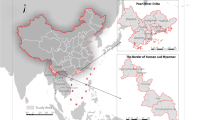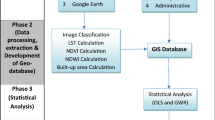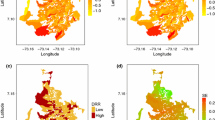Abstract
Dengue fever is expanding rapidly in many tropical and subtropical countries since the last few decades. However, due to limited research, little is known about the spatial patterns and associated risk factors on a local scale particularly in the newly emerged areas. In this study, we explored spatial patterns and evaluated associated potential environmental and socioeconomic risk factors in the distribution of dengue fever incidence in Jhapa district, Nepal. Global and local Moran’s I were used to assess global and local clustering patterns of the disease. The ordinary least square (OLS), geographically weighted regression (GWR), and semi-parametric geographically weighted regression (s-GWR) models were compared to describe spatial relationship of potential environmental and socioeconomic risk factors with dengue incidence. Our result revealed heterogeneous and highly clustered distribution of dengue incidence in Jhapa district during the study period. The s-GWR model best explained the spatial association of potential risk factors with dengue incidence and was used to produce the predictive map. The statistical relationship between dengue incidence and proportion of urban area, proximity to road, and population density varied significantly among the wards while the associations of land surface temperature (LST) and normalized difference vegetation index (NDVI) remained constant spatially showing importance of mixed geographical modeling approach (s-GWR) in the spatial distribution of dengue fever. This finding could be used in the formulation and execution of evidence-based dengue control and management program to allocate scare resources locally.








Similar content being viewed by others
Notes
VDC/municipalities boundaries in Nepal are rather unstable and changing continuously in the recent years. We have considered the boundaries at time of last census enumeration in 2011 because base population and dengue data both were available at ward level at time of census enumeration.
References
Acharya BK, Cao CX, Lakes T, Chen W, Naeem S (2016) Spatiotemporal analysis of dengue fever in Nepal from 2010 to 2014. BMC Public Health 16(1):849. https://doi.org/10.1186/s12889-016-3432-z
Acharya BK, Cao C, Min X, Chen W, Pandit S (2018) Spatiotemporal distribution and geospatial diffusion patterns of 2013 dengue outbreak in Jhapa District, Nepal. Asia Pac J Public Health. https://doi.org/10.1177/1010539518769809
Akhtar R, Gupta PT, Srivastava AK (2016) Urbanization, urban heat island effects and dengue outbreak in Delhi. In: Akhtar R (ed) Climate Change and Human Health Scenario in South and Southeast Asia. Springer International Publishing, Cham, pp 99–111. https://doi.org/10.1007/978-3-319-23684-1_7
Anselin L (2010) Local indicators of spatial association-LISA. Geogr Anal 27(2):93–115. https://doi.org/10.1111/j.1538-4632.1995.tb00338.x
Araujo RV, Albertini MR, Costa-da-Silva AL, Suesdek L, Franceschi NCS, Bastos NM, Katz G et al (2014) São Paulo urban heat islands have a higher incidence of dengue than other urban areas. Braz J Infect Dis 19:146–155. https://doi.org/10.1016/j.bjid.2014.10.004
Arboleda S, Jaramillo-O N, Peterson AT (2009) Mapping environmental dimensions of dengue fever transmission risk in the Aburrá Valley, Colombia. Int J Environ Res Public Health 6(12):3040–3055. https://doi.org/10.3390/ijerph6123040
Arya SC, Agarwal N (2014) Re: first isolation of dengue virus from the 2010 epidemic in Nepal. Trop Med Health 42(2):93–94. https://doi.org/10.2149/tmh.2013-31
Beck L (2000) Remote sensing and human health: new sensors and new opportunities. Emerg Infect Dis 6(3):217–227. https://doi.org/10.3201/eid0603.000301
Bhatt S, Gething PW, Brady OJ, Messina JP, Farlow AW, Moyes CL, Drake JM, Brownstein JS, Hoen AG, Sankoh O, Myers MF, George DB, Jaenisch T, Wint GRW, Simmons CP, Scott TW, Farrar JJ, Hay SI (2013) The global distribution and burden of dengue. Nature 496(7446):504–507. https://doi.org/10.1038/nature12060
Brady OJ, Johansson MA, Guerra CA, Bhatt S, Golding N, Pigott DM, Delatte H, Grech MG, Leisnham PT, Maciel-de-Freitas R, Styer LM, Smith DL, Scott TW, Gething PW, Hay SI (2013) Modelling adult Aedes Aegypti and Aedes Albopictus survival at different temperatures in laboratory and field settings. Parasit Vectors 6(1):351. https://doi.org/10.1186/1756-3305-6-351
Brunsdon C, Fotheringham S, Charlton M (1998) Geographically weighted regression. J R Stat Soc Ser D (The Statistician) 47(3):431–443. https://doi.org/10.1111/1467-9884.00145
Brunsdon C, Fotheringham AS, Charlton M (1999) Some notes on parametric significance tests for geographically weighted regression. J Reg Sci 39(3):497–524. https://doi.org/10.1111/0022-4146.00146
Brunsdon C, Fotheringham AS, Charlton ME (2010) Geographically weighted regression: a method for exploring spatial nonstationarity. Geogr Anal 28(4):281–298. https://doi.org/10.1111/j.1538-4632.1996.tb00936.x
Buck KD (2016) Modelling of geographic cancer risk factor disparities in US counties. Appl Geogr 75:28–35. https://doi.org/10.1016/j.apgeog.2016.08.001
Central Bureau of Statistics (CBS) (2011a) National population census 2011 household and population by sex ward. Kathmandu. http://cbs.gov.np/sectoral_statistics/population/wardlevel
Central Bureau of Statistics (CBS) (2011b) National population census 2011 household national report. CBS. http://cbs.gov.np/image/data/Population/National%20Report/National%20Report.pdf
Chavez PS (1996) Image-based atmospheric corrections—revisited and improved. Photogramm Eng Remote Sens 62(9):1025–1036
Corner RJ, Dewan AM, Hashizume M (2013) Modelling typhoid risk in Dhaka metropolitan area of Bangladesh: the role of socio-economic and environmental factors. Int J Health Geogr 12(1):13. https://doi.org/10.1186/1476-072X-12-13
Cressie NAC (1993) Statistics for spatial data: cressie/statistics. Wiley Series in Probability and Statistics. Hoboken: Wiley. https://doi.org/10.1002/9781119115151
Delmelle E, Hagenlocher M, Kienberger S, Casas I (2016) A spatial model of socioeconomic and environmental determinants of dengue fever in Cali, Colombia. Acta Trop 164:169–176. https://doi.org/10.1016/j.actatropica.2016.08.028
DOHS (2015) Annual Report, 2013-2014. In Annu Rep, 2013–2014, 2013th–2014th ed. Government of Nepal, Ministry of Health and Population, Department of Health Services, Teku, Kathmandu
Ehlkes L, Krefis A, Kreuels B, Krumkamp R, Adjei O, Ayim-Akonor M, Kobbe R, Hahn A, Vinnemeier C, Loag W, Schickhoff U, May J (2014) Geographically weighted regression of land cover determinants of plasmodium falciparum transmission in the Ashanti region of Ghana. Int J Health Geogr 13(1):35. https://doi.org/10.1186/1476-072X-13-35
Estallo EL, Ludueña-Almeida FF, Visintin AM, Scavuzzo CM, Lamfri MA, Introini MV, Zaidenberg M, Almirón WR (2012) Effectiveness of normalized difference water index in modelling Aedes Aegypti house index. Int J Remote Sens 33(13):4254–4265. https://doi.org/10.1080/01431161.2011.640962
Fotheringham AS, Brunsdon C (2010) Local forms of spatial analysis. Geogr Anal 31(4):340–358. https://doi.org/10.1111/j.1538-4632.1999.tb00989.x
Ge Y, Song Y, Wang J, Liu W, Ren Z, Peng J, Binbin L (2016) Geographically weighted regression-based determinants of malaria incidences in Northern China: Ge et Al. Trans GIS 21:934–953. https://doi.org/10.1111/tgis.12259
Goodchild MF, Janelle DG (eds) (2004) Spatially integrated social science. Spatial information systems. Oxford Univ. Press, Oxford
Gubler DJ, Clark GG (1995) Dengue/dengue hemorrhagic fever: the emergence of a global health problem. Emerg Infect Dis 1(2):55–57. https://doi.org/10.3201/eid0102.9502004
Homan T, Maire N, Hiscox A, Di Pasquale A, Kiche I, Onoka K, Mweresa C et al (2016) Spatially variable risk factors for malaria in a geographically heterogeneous landscape, Western Kenya: an explorative study. Malar J 15(1). https://doi.org/10.1186/s12936-015-1044-1
Hsueh Y-H, Lee J, Beltz L (2012) Spatio-temporal patterns of dengue fever cases in Kaoshiung City, Taiwan, 2003–2008. Appl Geogr 34(May):587–594. https://doi.org/10.1016/j.apgeog.2012.03.003
Khormi HM, Kumar L (2011) Modeling dengue fever risk based on socioeconomic parameters, nationality and age groups: GIS and remote sensing based case study. Sci Total Environ 409(22):4713–4719. https://doi.org/10.1016/j.scitotenv.2011.08.028
Limper M, Thai KTD, Gerstenbluth I, Osterhaus ADME, Duits AJ, van Gorp ECM (2016) Climate factors as important determinants of dengue incidence in Curaçao. Zoonoses Public Health 63(2):129–137. https://doi.org/10.1111/zph.12213
Lin C-H, Wen T-H (2011) Using geographically weighted regression (GWR) to explore spatial varying relationships of immature mosquitoes and human densities with the incidence of dengue. Int J Environ Res Public Health 8(12):2798–2815. https://doi.org/10.3390/ijerph8072798
Mahabir RS, Severson DW, Chadee DD (2012) Impact of road networks on the distribution of dengue fever cases in Trinidad, West Indies. Acta Trop 123(3):178–183. https://doi.org/10.1016/j.actatropica.2012.05.001
Manyangadze T, Chimbari MJ, Gebreslasie M, Mukaratirwa S (2016) Risk factors and micro-geographical heterogeneity of Schistosoma Haematobium in Ndumo area, UMkhanyakude District, KwaZulu-Natal, South Africa. Acta Trop 159:176–184. https://doi.org/10.1016/j.actatropica.2016.03.028
Martínez-Bello DA, López-Quílez A, Torres Prieto A (2017) Relative risk estimation of dengue disease at small spatial scale. Int J Health Geogr 16(1):31. https://doi.org/10.1186/s12942-017-0104-x
Matisziw TC, Grubesic TH, Wei H (2008) Downscaling spatial structure for the analysis of epidemiological data. Comput Environ Urban Syst 32(1):81–93. https://doi.org/10.1016/j.compenvurbsys.2007.06.002
Matthews SA, Yang T-C (2012) Mapping the results of local statistics: using geographically weighted regression. Demogr Res 26:151–166. https://doi.org/10.4054/DemRes.2012.26.6
McFEETERS SK (1996) The use of the normalized difference water index (NDWI) in the delineation of open water features. Int J Remote Sens 17(7):1425–1432. https://doi.org/10.1080/01431169608948714
Méndez-Lázaro P, Muller-Karger F, Otis D, McCarthy M, Peña-Orellana M (2014) Assessing climate variability effects on dengue incidence in San Juan, Puerto Rico. Int J Environ Res Public Health 11(9):9409–9428. https://doi.org/10.3390/ijerph110909409
Messina JP, Brady OJ, Pigott DM, Golding N, Kraemer MUG, Scott TW, Wint GRW, Smith DL, Hay SI (2015) The many projected futures of dengue. Nat Rev Microbiol 13(4):230–239. https://doi.org/10.1038/nrmicro3430
Mondal B, Das DN, Dolui G (2015) Modeling spatial variation of explanatory factors of urban expansion of Kolkata: a geographically weighted regression approach. Model Earth Syst Environ 1(4). https://doi.org/10.1007/s40808-015-0026-1
Moran PAP (1948) The interpretation of statistical maps. J R Stat Soc 10(2):243–251
Moreno-Madriñán M, Crosson W, Eisen L, Estes S, Maurice Estes MH Jr, Hemmings S et al (2014) Correlating remote sensing data with the abundance of pupae of the dengue virus mosquito vector, Aedes Aegypti, in Central Mexico. ISPRS Int J Geo-Inf 3(2):732–749. https://doi.org/10.3390/ijgi3020732
Nakaya T (2016) GWR4.09 user manual
Nakaya T, Fotheringham AS, Brunsdon C, Charlton M (2005) Geographically weighted Poisson regression for disease association mapping. Stat Med 24(17):2695–2717. https://doi.org/10.1002/sim.2129
Ord JK, Getis A (2010) Local spatial autocorrelation statistics: distributional issues and an application. Geogr Anal 27(4):286–306. https://doi.org/10.1111/j.1538-4632.1995.tb00912.x
Pandey BD, Rai SK, Morita K, Kurane I (2004) First case of dengue virus infection in Nepal. Nepal Med Coll J 6(2):157–159
Qi X, Wang Y, Li Y, Meng Y, Chen Q, Ma J, Gao GF (2015) The effects of socioeconomic and environmental factors on the incidence of dengue fever in the Pearl River Delta, China, 2013. Edited by David Harley. PLOS Negl Trop Dis 9(10):e0004159. https://doi.org/10.1371/journal.pntd.0004159
Ramezankhani R, Hosseini A, Sajjadi N, Khoshabi M, Ramezankhani A (2017) Environmental risk factors for the incidence of cutaneous Leishmaniasis in an endemic area of Iran: a GIS-based approach. Spat Spatiotemporal Epidemiol 21:57–66. https://doi.org/10.1016/j.sste.2017.03.003
Ren H, Zheng L, Li Q, Yuan W, Lu L (2017) Exploring determinants of spatial variations in the dengue fever epidemic using geographically weighted regression model: a case study in the joint Guangzhou-Foshan area, China, 2014. Int J Environ Res Public Health 14(12):1518. https://doi.org/10.3390/ijerph14121518
Ribeiro MC, Sousa AJ, Pereira MJ (2015) A Coregionalization model to assist the selection process of local and global variables in semi-parametric geographically weighted Poisson regression. Procedia Environ Sci 26:53–56. https://doi.org/10.1016/j.proenv.2015.05.023
Roslan NS, Latif ZA, Dom NC (2016) Dengue cases distribution based on land surface temperature and elevation. IEEE 87–91. https://doi.org/10.1109/ICSGRC.2016.7813307
Rouse JW Jr, Haas RH, Schell JA, Deering DW (1974) Monitoring vegetation systems in the Great Plains with Erts. 309–17. https://ntrs.nasa.gov/archive/nasa/casi.ntrs.nasa.gov/19740022614.pdf
Tobler WR (1970) A computer movie simulating urban growth in the Detroit region. Econ Geogr 46:234. https://doi.org/10.2307/143141
Troyo A, Fuller DO, Calderón-Arguedas O, Solano ME, Beier JC (2009) Urban structure and dengue incidence in Puntarenas, Costa Rica. Singap J Trop Geogr 30(2):265–282. https://doi.org/10.1111/j.1467-9493.2009.00367.x
Tu J, Xia Z (2008) Examining spatially varying relationships between land use and water quality using geographically weighted regression I: model design and evaluation. Sci Total Environ 407(1):358–378. https://doi.org/10.1016/j.scitotenv.2008.09.031
Uddin K, Shrestha HL, Murthy MSR, Bajracharya B, Shrestha B, Gilani H, Pradhan S, Dangol B (2015) Development of 2010 National Land Cover Database for the Nepal. J Environ Manag 148:82–90. https://doi.org/10.1016/j.jenvman.2014.07.047
Wabiri N, Shisana O, Zuma K, Freeman J (2016) Assessing the spatial nonstationarity in relationship between local patterns of HIV infections and the covariates in South Africa: a geographically weighted regression analysis. Spat Spatiotemporal Epidemiol 16:88–99. https://doi.org/10.1016/j.sste.2015.12.003
Wijayanti SPM, Porphyre T, Chase-Topping M, Rainey SM, McFarlane M, Schnettler E, Biek R, Kohl A (2016) The importance of socio-economic versus environmental risk factors for reported dengue cases in Java, Indonesia. Edited by Marilia Sá Carvalho. PLOS Negl Trop Dis 10(9):e0004964. https://doi.org/10.1371/journal.pntd.0004964
Wu P-C, Lay J-G, Guo H-R, Lin C-Y, Lung S-C, Su H-J (2009) Higher temperature and urbanization affect the spatial patterns of dengue fever transmission in subtropical Taiwan. Sci Total Environ 407(7):2224–2233. https://doi.org/10.1016/j.scitotenv.2008.11.034
Zha Y, Gao J, Ni S (2003) Use of normalized difference built-up index in automatically mapping urban areas from TM imagery. Int J Remote Sens 24(3):583–594. https://doi.org/10.1080/01431160304987
Zheng S, Cao CX, Cheng JQ, Wu YS, Xie X, Xu M (2014) Epidemiological features of hand-foot-and-mouth disease in Shenzhen, China from 2008 to 2010. Epidemiol Infect 142(08):1751–1762. https://doi.org/10.1017/S0950268813002586
Acknowledgements
We would like to express our sincere gratitude to Epidemiology and Disease Control Division (EDCD), Department of Health Services, Government of Nepal, for providing us dengue data. We are also thankful to Dr. Surendra Karki, University of Illinois, Urbana-Champaign, USA, and Dr. Laxman Khanal, Central Department of Zoology, Institute of Science and Technology, Tribhuvan University, Kathmandu, Nepal, and two anonymous reviewers for the feedback and comments on an early version of this manuscript. Two authors, Bipin Kumar Acharya and Shahid Naeem, acknowledge the Chinese Academy of Sciences (CAS) and The World Academy of Sciences (TWAS) for awarding the CAS-TWAS President’s fellowship for their PhD study.
Funding
The work in this paper was financially supported by the National Key Research and Development Program of China (No. 2016YFB0501505) and the Natural Science Foundation of China (No. 41601368).
Author information
Authors and Affiliations
Corresponding author
Ethics declarations
Conflict of interest
The authors declare that they have no conflict of interest.
Rights and permissions
About this article
Cite this article
Acharya, B.K., Cao, C., Lakes, T. et al. Modeling the spatially varying risk factors of dengue fever in Jhapa district, Nepal, using the semi-parametric geographically weighted regression model. Int J Biometeorol 62, 1973–1986 (2018). https://doi.org/10.1007/s00484-018-1601-8
Received:
Revised:
Accepted:
Published:
Issue Date:
DOI: https://doi.org/10.1007/s00484-018-1601-8




